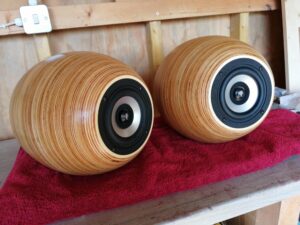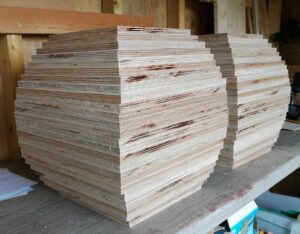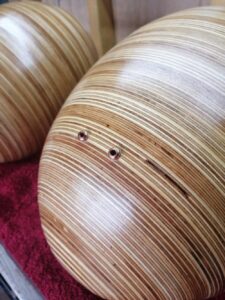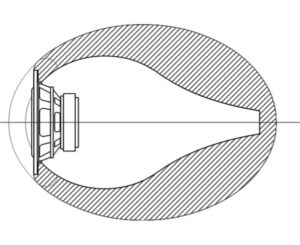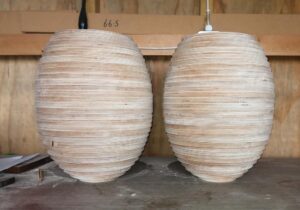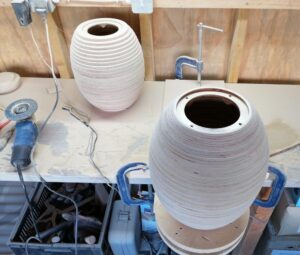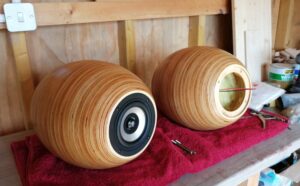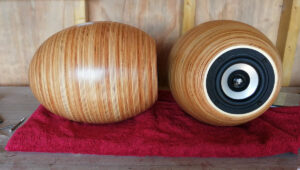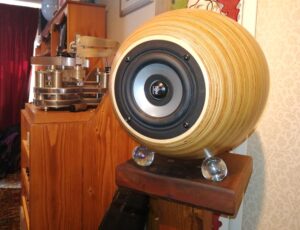This is a highly unusual enclosure for the Jordan Eikona full-range loudspeaker. It has been carefully designed and executed by one of our UK customers. A detailed construction thread is available on the DIYaudio website and we asked Nathan for permission to describe the project.
The aim of this design was to achieve the best possible sound quality with a visually beautiful enclosure. To this end, Nathan designed an ellipsoid shape constructed of a laminate of 29 layers of 12 mm plywood panels. (This is becoming a popular construction method with Eikona users.) The cabinet was built in sections to allow access to the interior and once the ply panels were stacked and glued together, each section of the enclosure was sanded smooth, both externally and internally.
The external shape isn’t just for appearance; it’s smooth surfaces and rounded shape should help stereo imaging, with no reflections from cabinet edges. The internal shape doesn’t follow that of the exterior but has been carefully designed to focus and absorb as much of the rear radiation from the Eikona as possible.
It’s a very impressive project, with careful attention to detail – even the loudspeaker connection sockets were built especially to avoid spoiling the elegant shape of the enclosure.
We asked Nathan to explain his thinking behind the project and his listening impressions:
DESIGN
I chose the Eikona drive unit for several reasons, some of which are specific to the Jordans and some to full-range drivers in general.
I occasionally visit hifi shows. Every time I do, I find that most of the systems that I really enjoy are either using full-range drivers by themselves or with powered subwoofers. With virtually all of the multiway speakers, I find the crossovers really obvious. I can usually pretty accurately state what the crossover frequency is with just a quick listen. The sound is nearly always disjointed.
Of the full-range drivers that I’ve heard, the two brands that have impressed me the most are Jordan and Voxative. The two brands definitely have different sounds. Overall, I lean towards the more neutral sound of the Jordans, though I could happily live with either. The main advantage of the Jordan over the Voxative is the price. The Voxative drivers are massively more expensive than the Jordans.
Jordan drivers are insanely good value for money. To build a two-way you would need to buy a pair of mid bass units, a pair of tweeters and all the components for the crossover for the same price. (If you are new to speaker building, you will probably also need to buy a calibrated microphone and design software.)
If I were to go down the separate mid-bass and tweeter approach, I would have to mount one drive unit above the other. This will inevitably result in a certain amount of vertical integration problems at the crossover frequency. A full-range driver acts as a point source, so won’t have this problem and should result in better imaging …
CABINET
One of the benefits of translam is the ability to make more complex shapes, both external and internal, than is possible with more conventional construction. Translam can be done with only a relatively modest toolkit, and the material is cheap. Even though I am using high quality Baltic birch plywood, the total cost of building my cabinets, including all the tools, fixings and finishing materials, is less than £200.
Finally, if done well, translam produces a really good finish.
My design is for a 4.5 litre sealed box, with a Q of 0.65 and a -3dB point of 86 Hz. The cabinet is 280 mm diameter and the wall thickness varies from 40 mm at the front to 100 mm near the rear.
The front section is an ellipsoid, to avoid the formation of standing waves, and the rear section is a logarithmic cone that smoothly transitions from the front section. All sound waves emanating from the driver are reflected towards the rear of the cabinet. Apart from the small flat rear panel, which is only 32 mm in diameter, there are no surfaces that can reflect sound back towards the driver.
As sound waves travel towards the rear of the cabinet, their amplitude will become greater. To promote the sound being reflected to the rear, the inside surface is smooth so that it acts as an acoustic mirror. The absorbent wadding (Twaron Elves Hair from Mundorf) is inserted in such a way that there is an equal weight of wadding per unit length of the speaker. This means that the density of the wadding increases exponentially towards the rear of the speaker.
SOUND QUALITY
I have a little tradition. Every time I upgrade or make a significant change, I always play something by Leonard Cohen first.
I had come into this project with high expectations. I am very familiar with the Jordan JX92 driver. Probably the best system that I have ever heard used a short line of 4 Jordan JX92s per channel. The rest of this system is about 10 times the cost of mine so if I can get in the same ball park, I’ll be happy. The majority of people who have experience of both JX92 and Eikona prefer the Eikona, so hopefully I’m off to a good start.
As this are Jordan drivers, I expected midrange magic and these speakers do not disappoint. They have a richness and smoothness but also a real sense of solidity. Often when you find a speaker with warmth and richness in the midrange it can sound a bit airy and diaphanous. Although these speakers have a real sense of space and air around each image, the image is solid. I don’t just mean solidly located but also that the sound is emanating from something solid. Vocals don’t hang in space, they stand in space. The quality of the midrange is probably largely down to not having a crossover mucking everything up.
I had been a bit worried that the quality of the top end might be lacking compared to using a dedicated tweeter and that any cone breakup might add a bit of harshness in the sibilance region. The top end of the Eikona is beautifully extended and smooth. No need to worry at all. Many people who use the JX92s add a super-tweeter to fill out the top end. With the Eikona this is not at all necessary. I think that the improvement in the top end is one of the biggest differences between the two drivers.
When I initially set up the speakers, I ran them without the subwoofer. Even in a sealed cabinet they go surprisingly low. More importantly, as they give up at lower frequencies, they do so with real decorum. They don’t complain or try to force out notes that are beyond them, they just bow out gracefully. My previous speakers gave up with much more complaint, the distortion of the bottom end colouring the midrange. The addition of a high pass filter helped cure this.
They sound like the -3dB point is lower than the calculated 86 Hz. It probably isn’t but because of the way they roll off, it sounds like it. More important than bass depth is bass articulation. You get a real sense of the character of bass notes. I have heard it said that to improve your bass, upgrade your tweeter. This is because the character of bass instruments is carried in their harmonics at higher frequencies. If you stick a crossover into the mix, much of the harmonics will not be in phase with the fundamental. The parts of the sound don’t line up anymore and the character is lost.
I had been holding the idea of adding an active filter in reserve. This would have been used if the bottom end gave up with any signs of distress. As the roll off has no issues, one is not required here. Likewise, there is no audible breakup in the sibilance region so no notch filters or similar are required either. The final possible filter would be for baffle step. Possibly due to the shape of the cabinet, baffle step doesn’t seem to be a problem. The bottom end sounds perfectly in balance with the midrange. With these speakers, absolutely no additional filtering is required. Not only does this avoid putting anything in the signal path that could mess with the phase coherence of the speakers it also saves on the cost of building said filter system.
The one area of sound quality that keeps surprising me is what I refer to as mid-bass. This is the bit between the upper-bass and lower-midrange, in the range 200-500 Hz. It is so clean and tight. Wooden-bodied instruments and toms have real character. This could be due to the driver being so much lighter than one that would normally be used for this frequency range.
The general consensus and Jordan’s recommendation is that they should be toed-in so that the axes cross a good distance in front of the listening position. My experiments seem to confirm this advice.
What really made a huge difference was pulling the speakers an extra foot into the room. The soundstage exploded when I did this, huge, focused and solid. Unfortunately, this is not a position where they can live permanently. I would love to try them in a larger room where I can get them 3′ or 4′ into the room.
Whilst moving the speakers around I noticed something slightly uncanny. I had my head close to a speaker and the sound all appeared to emanate from just in front of the phase plug. It appears to come from here regardless of where I listen from. Normally, sound appears to come from a speaker more as a whole. This would suggest that rounding off the cabinet has had a profound effect. You normally get a lot of clues as to the location of the cabinet from the sound diffracted from its edges.
Compared to other drivers that I have experimented with (which is a lot, I worked for a hifi dealer for 10 yrs and ran their servicing department), the Eikonas don’t seem to change as much as most with run-in. They are definitely sounding smoother through the midrange and top end but haven’t lost any of their incisiveness or bite.
Basically, I’m loving the sound of these speakers. I think all the work required to make the complex cabinets has definitely paid off.
Very happy.


